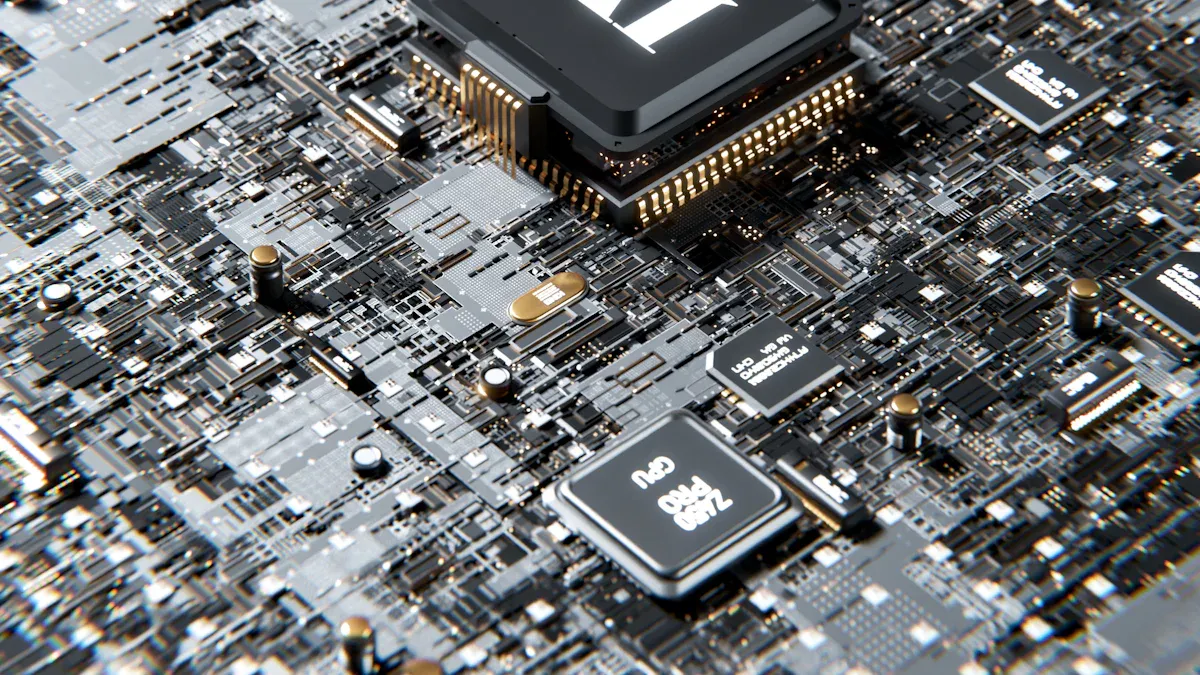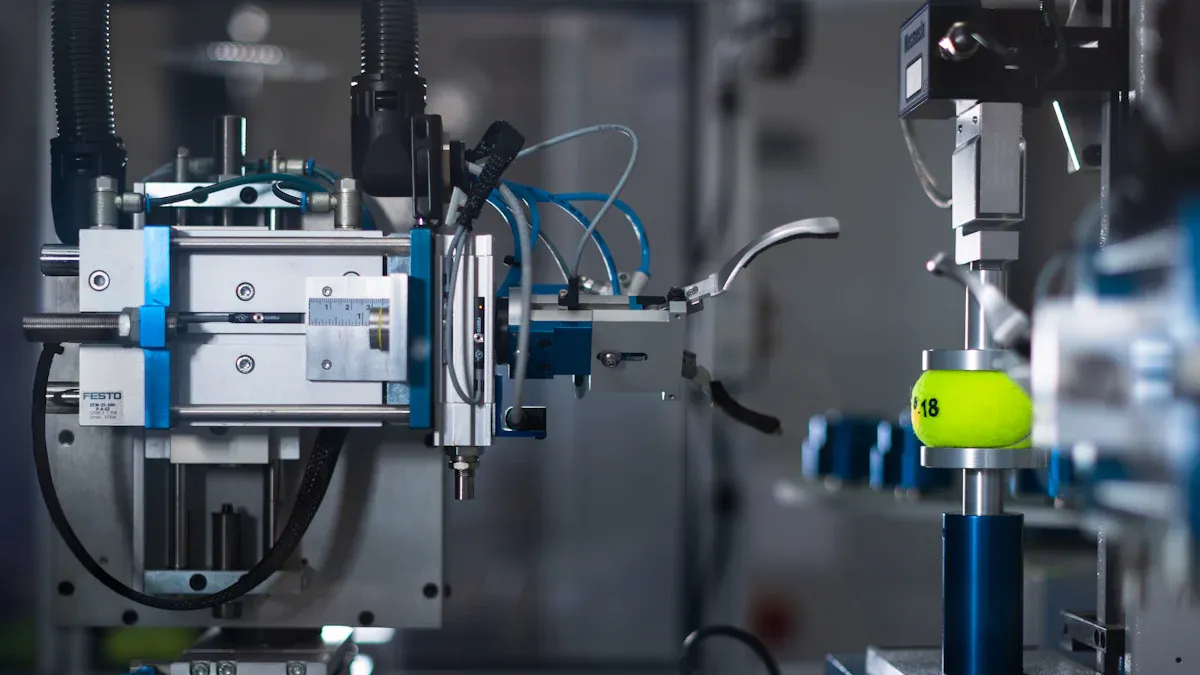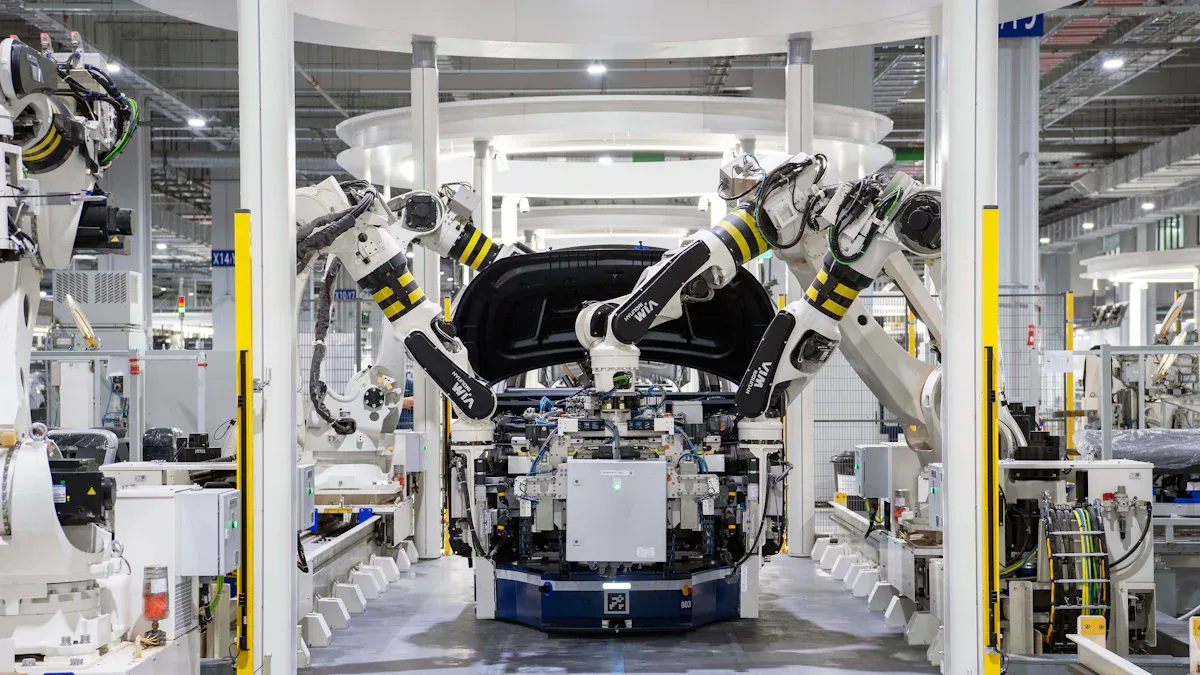
AI has revolutionized the injection molding industry, transforming how you approach manufacturing processes. With AI-driven injection molding machines, you gain the ability to optimize production in ways that were once unimaginable. For instance, a study of 150 automotive manufacturing plants showed a 35% reduction in defect rates within the first year of implementing AI-based quality control systems. Another manufacturer reduced out-of-specification parts from 3.2% to 0.8%, saving €2.3 million annually. These advancements highlight how AI not only improves precision but also reduces waste, making injection molding more efficient and cost-effective for businesses like yours.

AI in injection molding has introduced groundbreaking capabilities for real-time adjustments. With advanced data collection methods, AI-driven injection molding machines monitor equipment performance and environmental factors like temperature and humidity. Intelligent sensor networks detect anomalies instantly, allowing you to address issues before they escalate. This proactive approach minimizes downtime and ensures consistent production quality.
Machine learning algorithms analyze both historical and real-time data to identify patterns and predict potential inefficiencies. For example, AI can pinpoint the root causes of production slowdowns by examining trends in molding processes. This enables targeted improvements that maximize uptime and reduce scrap rates. By leveraging AI-driven process control, you can achieve unparalleled precision and efficiency in your operations.
AI-driven tools have revolutionized efficiency and precision in plastic injection molding. Studies show that AI systems can reduce production time by 12%, raw material usage by 2%, and energy consumption by 16%. These improvements not only lower costs but also enhance sustainability in manufacturing.
A key advantage of AI-driven optimization lies in its ability to support repeatability and optimization. For instance, AI systems optimize processing parameters to minimize defects and ensure consistent quality. Research by R. Joseph Bensingh et al. demonstrated how AI achieved minimal variance in volume shrinkage deformation, highlighting its reliability for high-precision applications. Similarly, Ming-Shyan Huang et al. used machine learning to predict part dimensions with over 92% accuracy, showcasing the potential of data-driven precision in injection molding.
Industries requiring high accuracy, such as medical devices and electronics, greatly benefit from AI-driven injection molding. AI systems enable precise control over molding parameters, ensuring that each part meets exact specifications. This level of precision is critical for applications where even minor deviations can compromise functionality or safety.
AI also enhances design and prototyping processes. By reducing mold design time by 30-50% and inspection time by 40%, AI accelerates product development cycles. Additionally, predictive maintenance capabilities lower mold maintenance costs and increase production capacity by 20%. These advancements make AI-driven injection molding machines indispensable for industries that demand both precision and efficiency.
Tip: Adopting AI in injection molding not only improves product quality but also strengthens your competitive edge in high-accuracy markets.
AI has transformed how you approach equipment maintenance in injection molding. By continuously collecting data on critical performance metrics like vibration, temperature, and pressure, AI systems can detect anomalies that signal potential equipment failures. These systems analyze historical and real-time data to predict when a machine might fail, allowing you to address issues before they disrupt production.
For example, AI algorithms use anomaly detection to identify deviations from normal operation. This ensures that maintenance is performed only when necessary, reducing unnecessary interventions. Key metrics like accuracy and real-time monitoring demonstrate how effectively AI sensors and algorithms monitor equipment.
| Metric | Description |
|---|---|
| Accuracy | Measures the correctness of predictions made by AI models. |
| Silhouette Score | Evaluates the quality of clusters formed by unsupervised learning models. |
| Real-time Monitoring | Continuous observation of critical parameters to ensure optimal performance. |
| Anomaly Detection | Identifies deviations from normal operation, indicating potential failures. |
| Model Retraining Effectiveness | Assesses how well the model adapts to new data over time. |
By leveraging these capabilities, you can minimize unexpected breakdowns and maintain consistent production quality.
AI-driven predictive analytics optimize maintenance schedules, helping you reduce downtime and extend the lifespan of your injection molding equipment. Instead of relying on fixed maintenance intervals, AI enables a proactive approach. This ensures that repairs occur only when necessary, preventing costly delays.
Key performance indicators (KPIs) like Mean Time Between Failures (MTBF) and Mean Time to Repair (MTTR) provide measurable insights into equipment performance. For every $1 spent on preventive maintenance, you can achieve a return on investment (ROI) of $3. This financial benefit highlights the value of integrating AI into your maintenance strategy.
By addressing potential issues early, you not only save money but also improve the reliability of your equipment. This approach ensures that your injection molding operations run smoothly and efficiently.
AI solutions enhance overall equipment effectiveness (OEE) by preventing defects and optimizing production. Real-time data collection from in-line sensors allows you to monitor performance and identify downtime causes. AI tools analyze this data to provide actionable insights, enabling you to improve machine utilization and production rates.
For example, contextualizing performance data against production metrics helps you identify inefficiencies. AI-driven strategies based on actual machine operation data lead to scalable and optimized production. By integrating AI into your injection molding processes, you can achieve higher OEE and maintain a competitive edge in the manufacturing industry.
Note: Improving OEE with AI not only boosts productivity but also ensures long-term sustainability for your operations.

AI-powered real-time quality control has transformed defect detection in injection molding. By leveraging advanced machine learning algorithms and sensor technologies, you can identify defects as they occur during production. This approach eliminates the need for post-production inspections, saving time and resources.
For instance, AI systems monitor over 300 sensors to collect data on critical parameters like temperature, pressure, and material flow. These systems analyze the data in real time to detect anomalies that may lead to defects. A 90-day pilot study revealed that two defect types accounted for 80% of scrap rates. By implementing AI, manufacturers achieved a 25% improvement in defect rates, showcasing the effectiveness of real-time monitoring.
AI-driven vision systems also play a crucial role in defect detection. These systems scan parts at high speeds, ensuring that even the smallest imperfections are identified. BMW, for example, uses Vision AI to scan parts at 2,000 frames per second with 99.98% accuracy. This level of precision ensures defect-free production, even in high-volume manufacturing environments.
Tip: Integrating AI-powered real-time quality control into your injection molding processes can help you achieve consistent product quality while reducing waste.
AI has proven to be a game-changer in reducing defect rates and minimizing waste in plastic injection molding. By analyzing historical and real-time data, AI systems optimize production parameters to prevent defects before they occur. This proactive approach not only improves product quality but also enhances sustainability by reducing material waste.
Toyota's iQ Weight Control system is a prime example of how AI can reduce waste. This system adjusts shot size based on real-time resin density, ensuring optimal material usage. As a result, Toyota saves $1.2 million annually while maintaining high-quality standards. Similarly, Medtronic's APC Plus system stabilizes melt viscosity during production, leading to a 27% reduction in defects.
AI also enables manufacturers to identify and address the root causes of defects. For example, computer vision thermography uses infrared cameras to detect cooling issues and internal voids in molded parts. By addressing these issues early, you can prevent defects from escalating, ensuring a smoother production process.
Note: Reducing defect rates with AI not only lowers costs but also strengthens your commitment to sustainable manufacturing practices.
Several manufacturers have successfully implemented AI-driven quality control methods to enhance their injection molding processes. These case studies highlight the versatility and effectiveness of AI in achieving defect-free production:
These examples demonstrate how AI-powered quality control innovations can address a wide range of challenges in injection molding. By adopting these technologies, you can improve product quality, reduce waste, and enhance operational efficiency.
Callout: Case studies like these prove that AI is not just a tool for defect detection but a comprehensive solution for achieving excellence in injection molding.
AI has revolutionized material selection in plastic injection molding processes. By analyzing complex design rules and material properties, AI helps you choose the best materials for your products. It optimizes manufacturing constraints, enabling faster design iterations and reducing the risk of defects. For example, AI evaluates factors like material flow, cooling rates, and stress distribution to ensure high performance and minimal waste.
The table below highlights how AI monitors critical parameters during injection molding to improve product quality:
| Parameter | Effect on Molded Products | Risk of Defects Ignored |
|---|---|---|
| Mold Temperature | Varies | Yes |
| Melt Temperature | Varies | Yes |
| Injection Time | Varies | Yes |
| Injection Speed | Varies | Yes |
| Injection Pressure | Varies | Yes |
| Screw Rotation Speed | Varies | Yes |
| Shot Size | Varies | Yes |
| Holding Time | Varies | Yes |
| Cooling Time | Varies | Yes |
By leveraging AI for predictive analytics, you can minimize defects and maximize efficiency in your plastic injection molding processes.
Customization in injection molding has become more accessible with AI. You can now produce tailored products at scale without compromising efficiency. AI-driven systems analyze customer requirements and adjust production parameters in real time. This allows you to create unique designs while maintaining consistent quality.
For instance, AI enables rapid prototyping by optimizing mold designs and reducing lead times. It also ensures that each product meets exact specifications, making it ideal for industries like automotive and consumer goods. With AI, you can achieve mass customization while keeping costs under control.
AI has expanded the applications of plastic injection molding across various industries. In the medical field, AI ensures precision and compliance with strict quality standards. This is crucial for products like syringes and catheters, where even minor defects can have serious consequences.
In electronics, AI supports the production of components with minimal tolerances. This is essential for devices like smartphones and wearables, where accuracy and durability are critical. As demand for consumer electronics grows, AI-driven injection molding systems help you meet these requirements efficiently.
AI also plays a role in other sectors, such as automotive and packaging. By enhancing precision and reducing waste, AI makes injection molding a versatile solution for diverse manufacturing needs.
Tip: Adopting AI in material science and customization can help you stay ahead in competitive industries by delivering high-quality, tailored products.
Digital twin technology is reshaping how you simulate and optimize injection molding processes. By creating a virtual replica of your production system, you can predict outcomes and refine parameters before actual production begins. This approach enhances simulation accuracy and ensures seamless integration between virtual and real-world operations.
For example, tools like CADMOULD and Moldex3D allow you to address issues like air inclusions and warpage during the design phase. These tools also streamline the start-up phase by automating data continuity and reducing delays. The table below highlights the advantages of digital twins in injection molding:
| Advantage | Description |
|---|---|
| Increases the quality of simulation | Enhances prediction accuracy in the injection molding process. |
| Direct data transfer | Facilitates seamless integration of simulation results into production. |
| Reduces start-up duration | Minimizes delays by streamlining processes. |
| Enables automated data continuity | Ensures consistent data flow between simulation and production. |
Generative mold design uses AI to create multiple design variants based on your specific constraints. This process accelerates mold design and improves production efficiency. For instance, researchers have used transfer learning to optimize parameters, leading to better surface quality and reduced energy consumption.
Self-optimizing factories take this a step further by using AI to monitor and adjust production variables in real time. These factories reduce weight differences in molded parts and improve energy efficiency. By adopting these technologies, you can achieve faster production cycles and lower operational costs.
AI-driven injection molding systems are paving the way for sustainable manufacturing. Autonomous systems optimize material usage and energy consumption, reducing waste and environmental impact. For example, AI can adjust shot sizes and cooling times to minimize resource use without compromising quality.
These systems also support circular manufacturing by enabling the use of recycled materials. As sustainability becomes a priority, adopting autonomous manufacturing systems can help you meet environmental goals while maintaining efficiency.
Tip: Embracing these future trends will not only enhance your production capabilities but also position your business as a leader in sustainable manufacturing.
Adopting AI in injection molding often comes with challenges like high costs and a lack of expertise. However, you can overcome these hurdles by taking strategic steps. Start by identifying repetitive or time-consuming tasks in your processes. Automating these areas, such as design standardization, can save time and reduce errors.
Using off-the-shelf AI tools is another cost-effective approach. These tools require minimal technical expertise and allow you to experiment without significant upfront investment. Embracing a culture of experimentation is equally important. Set clear objectives, document outcomes, and learn from failures to refine your strategies.
Focusing on specific pilot projects can also help you manage costs and resources effectively. For example, you might explore how AI can optimize injection parameters or improve defect detection. By concentrating your efforts, you can achieve measurable results without overextending your budget.
Tip: Start small and scale up as you gain confidence in AI-driven solutions.
Implementing AI successfully in injection molding requires a structured approach. Begin by assessing your workflows to identify inefficiencies. This helps you target areas where AI can deliver the most value. For instance, automating mold design or optimizing cooling times can significantly enhance productivity.
Utilizing existing AI tools is a practical way to get started. These tools often come with user-friendly interfaces, making them accessible even if your team lacks advanced technical skills. Additionally, focusing on specific projects allows you to test AI applications in a controlled environment.
A willingness to experiment is crucial. Not every attempt will succeed, but each failure provides valuable insights. Documenting these lessons helps you refine your approach and build a robust AI strategy.
Callout: Clear objectives and a focus on measurable outcomes are key to successful AI adoption.
Your workforce plays a critical role in the successful adoption of AI-driven injection molding technologies. Training programs can help bridge skill gaps and prepare your team for new challenges. Organizations like the WBLC have developed work-based learning programs to upskill workers in advanced manufacturing roles. These programs provide fast and cost-effective training for positions like mold maintenance technicians.
Investing in your current workforce is often more effective than hiring externally. By upgrading their skills, you can ensure they are equipped to handle advanced robotics and control systems. This approach not only improves efficiency but also fosters collaboration within your team.
Manufacturers increasingly recognize the importance of re-training employees in robotic technology application and maintenance. This focus on internal development highlights the value of a skilled and adaptable workforce.
Note: Workforce training is not just an investment in technology but also in the people who drive your operations forward.
AI-driven injection molding machines have revolutionized manufacturing by enhancing precision, efficiency, and sustainability. These advancements allow you to produce high-quality parts while reducing waste and operational costs. Adopting AI in your injection molding processes ensures you remain competitive in an industry that increasingly values innovation and adaptability.
Exploring AI-driven solutions opens the door to streamlined operations and improved product quality. By integrating these technologies, you can future-proof your business and meet the growing demands of modern manufacturing. Now is the time to embrace AI and unlock its full potential in your injection molding operations.
AI optimizes production parameters by analyzing real-time data. It reduces cycle times, minimizes material waste, and enhances energy efficiency. You can achieve faster production and lower costs while maintaining consistent quality.
Yes, AI-powered systems monitor molding processes in real time. They identify defects using sensors and machine learning algorithms. This ensures immediate corrective actions, reducing waste and improving product quality.
AI tools are scalable and adaptable. You can start with affordable, off-the-shelf solutions to automate specific tasks. This allows small-scale manufacturers to benefit from AI without significant upfront investments.
Industries like medical devices, electronics, automotive, and packaging benefit greatly. AI ensures precision, reduces defects, and supports mass customization, making it ideal for applications requiring high accuracy and efficiency.
Basic training helps your team understand AI tools and workflows. Many AI solutions come with user-friendly interfaces, making them accessible even without advanced technical expertise. Workforce upskilling ensures smooth adoption.